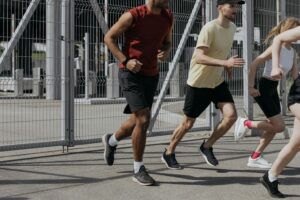Disclosure: Some links in this post may be affiliate links. This means I may earn a small commission if you purchase through them—at no extra cost to you. I only recommend gear I personally use and believe in!
If you’re familiar with the U.S. version of The Office, you might remember Michael Scott’s Dunder Mifflin Scranton Meredith Palmer Memorial Celebrity Rabies Awareness Pro-Am Fun Run Race for the Cure. In that episode, Andy freaks out about his nipples chafing—and sure enough, you see him in absolute pain. When I first saw that as a non-runner, I thought, What an exaggeration! But after logging some real miles, I can assure you—chafing is very real, and it can sneak up on even the most prepared runner.
In this post, we’ll cover what chafing actually is, what causes it, and how to prevent it. Plus, we’ll talk about those pesky blisters that tend to tag along for the ride.
What Is Chafing?
Chafing is an irritated, raw spot on the skin caused by repeated friction. It most commonly shows up on inner thighs, underarms, the waistband area, and yes—the infamous nipple area. Depending on your skin’s sensitivity, chafing can range from mild redness to stinging, burning patches, and in extreme cases, even light bleeding.
But here’s what many new runners don’t realize:
- Weather plays a big role. Humidity, heat, or rain can soften skin and make it more prone to irritation.
- Salt from sweat can worsen the burn. As sweat dries, salt crystals act like tiny sandpaper against your skin.
- It doesn’t just happen on long runs. Even short jogs in the wrong clothing can cause hotspots.
What Causes It?
The main culprit is friction—skin rubbing against skin, or fabric rubbing against skin. Loose or ill-fitting clothes make it worse, especially when combined with sweat or rain. Wet fabric loses its softness and becomes abrasive, which is why rainy runs can be extra painful.
Personally, I avoid running in the rain unless absolutely necessary because it almost always leads to blisters between my toes. And it’s not just the rain—hot, humid days can create the same conditions. Even your shoes and socks can cause tiny shifts that add up over miles.
Other sneaky triggers include:
- Old or worn-out running gear. Seams or rough edges on older clothes can rub more than you realize.
- Not using proper socks. Cotton traps moisture and makes blisters worse.
- Longer mileage without prep. As your runs get longer, the repetitive motion increases friction dramatically.
How Can We Avoid Chafing and Blisters?
While you may never completely eliminate blisters, you can definitely reduce the risk of both blisters and chafing with a few simple strategies:
✅ Wear moisture-wicking, fitted clothing. Look for seamless designs made for movement. Avoid cotton at all costs.
✅ Use anti-chafing balms. Products like BodyGlide or Vaseline create a protective barrier that reduces friction. I personally carry Body Glide in my running vest for my long runs just in case.
✅ Invest in proper socks. Synthetic or wool-blend socks that wick moisture are far better than standard cotton socks. In my gear list post I share what use on the daily,
✅ Break in your gear. Never wear brand-new shoes or clothes on a long run. Always test them on shorter runs first.
✅ Keep your skin dry. If you’re prone to heavy sweating, carrying a small towel or even using cornstarch-based powders can help.
✅ Know your hotspots. Once you figure out where you tend to chafe, you can proactively protect those areas before every run.
Remember—prevention is much easier (and less painful!) than dealing with raw skin after the fact. You can find what I use in this post.
But What If You Still Get Chafing or Blisters?
Even with the best prevention, sometimes the inevitable happens. Here’s how to treat them so you can heal quickly and keep running:
Treating Chafing
- Clean the area gently. Use mild soap and lukewarm water to wash away sweat and bacteria—avoid scrubbing!
- Pat dry and apply a healing ointment. Products with aloe vera, zinc, or petroleum jelly can soothe the irritation.
- Avoid further friction. Wear loose, soft fabrics until the skin heals. For nipple chafing, breathable bandages can protect the area.
- Let it breathe. At home, avoid tight clothes and let the skin air out whenever possible.
Treating Blisters
- Leave small, intact blisters alone. Your skin is a natural bandage.
- For painful blisters, drain carefully. Use a sterile needle to puncture at the edge and gently press out fluid—do NOT remove the overlying skin.
- Cover with a blister pad. Specialized blister bandages or moleskin help protect the area while it heals.
- Check your shoes. Blisters often mean your socks or shoes aren’t the right fit—or need replacing.
If a blister or chafed area shows signs of infection (like redness spreading, pus, or increased pain), it’s best to see a doctor.
Blisters and chafing might feel like small annoyances, but they can quickly derail your motivation if you’re just starting out. With a little preparation, you can stay comfortable and focused on what really matters—enjoying your run.
👉 Want more beginner-friendly running tips, gear guides, and training advice delivered straight to your inbox?
Sign up for my free email newsletter! You’ll get weekly tips that help you stay consistent, injury-free, and motivated on your running journey.
